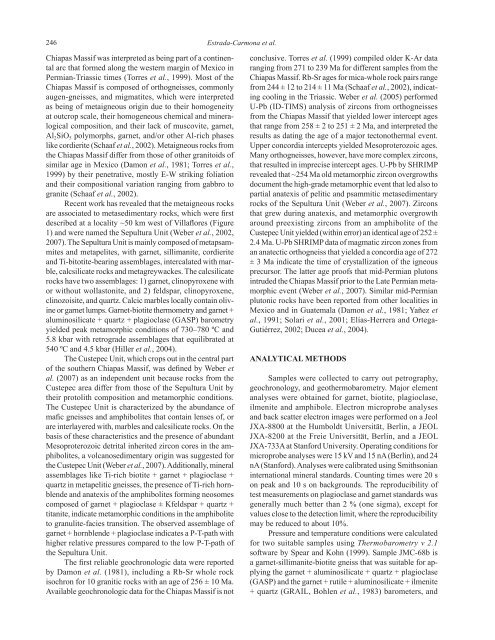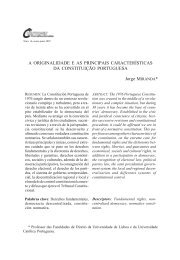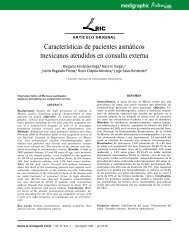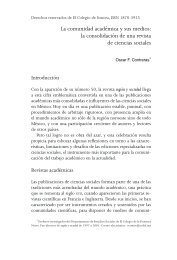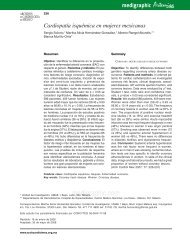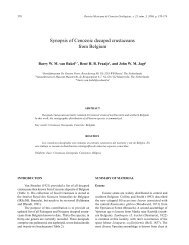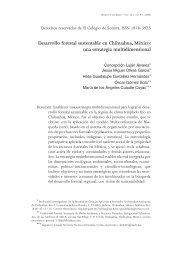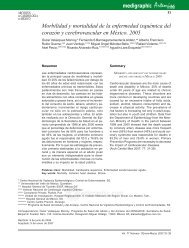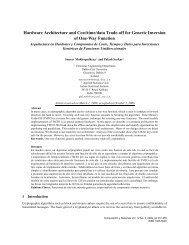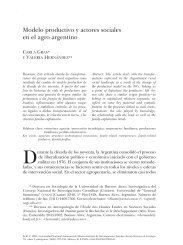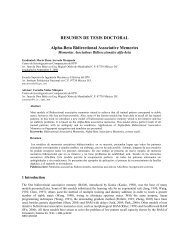P-T-t trajectory of metamorphic rocks from the central ... - SciELO
P-T-t trajectory of metamorphic rocks from the central ... - SciELO
P-T-t trajectory of metamorphic rocks from the central ... - SciELO
Create successful ePaper yourself
Turn your PDF publications into a flip-book with our unique Google optimized e-Paper software.
246<br />
Estrada-Carmona et al.<br />
Chiapas Massif was interpreted as being part <strong>of</strong> a continental<br />
arc that formed along <strong>the</strong> western margin <strong>of</strong> Mexico in<br />
Permian-Triassic times (Torres et al., 1999). Most <strong>of</strong> <strong>the</strong><br />
Chiapas Massif is composed <strong>of</strong> orthogneisses, commonly<br />
augen-gneisses, and migmatites, which were interpreted<br />
as being <strong>of</strong> metaigneous origin due to <strong>the</strong>ir homogeneity<br />
at outcrop scale, <strong>the</strong>ir homogeneous chemical and mineralogical<br />
composition, and <strong>the</strong>ir lack <strong>of</strong> muscovite, garnet,<br />
Al 2 SiO 5 polymorphs, garnet, and/or o<strong>the</strong>r Al-rich phases<br />
like cordierite (Schaaf et al., 2002). Metaigneous <strong>rocks</strong> <strong>from</strong><br />
<strong>the</strong> Chiapas Massif differ <strong>from</strong> those <strong>of</strong> o<strong>the</strong>r granitoids <strong>of</strong><br />
similar age in Mexico (Damon et al., 1981; Torres et al.,<br />
1999) by <strong>the</strong>ir penetrative, mostly E-W striking foliation<br />
and <strong>the</strong>ir compositional variation ranging <strong>from</strong> gabbro to<br />
granite (Schaaf et al., 2002).<br />
Recent work has revealed that <strong>the</strong> metaigneous <strong>rocks</strong><br />
are associated to metasedimentary <strong>rocks</strong>, which were first<br />
described at a locality ~50 km west <strong>of</strong> Villaflores (Figure<br />
1) and were named <strong>the</strong> Sepultura Unit (Weber et al., 2002,<br />
2007). The Sepultura Unit is mainly composed <strong>of</strong> metapsammites<br />
and metapelites, with garnet, sillimanite, cordierite<br />
and Ti-bitotite-bearing assemblages, intercalated with marble,<br />
calcsilicate <strong>rocks</strong> and metagreywackes. The calcsilicate<br />
<strong>rocks</strong> have two assemblages: 1) garnet, clinopyroxene with<br />
or without wollastonite, and 2) feldspar, clinopyroxene,<br />
clinozoisite, and quartz. Calcic marbles locally contain olivine<br />
or garnet lumps. Garnet-biotite <strong>the</strong>rmometry and garnet +<br />
aluminosilicate + quartz + plagioclase (GASP) barometry<br />
yielded peak <strong>metamorphic</strong> conditions <strong>of</strong> 730–780 ºC and<br />
5.8 kbar with retrograde assemblages that equilibrated at<br />
540 ºC and 4.5 kbar (Hiller et al., 2004).<br />
The Custepec Unit, which crops out in <strong>the</strong> <strong>central</strong> part<br />
<strong>of</strong> <strong>the</strong> sou<strong>the</strong>rn Chiapas Massif, was defined by Weber et<br />
al. (2007) as an independent unit because <strong>rocks</strong> <strong>from</strong> <strong>the</strong><br />
Custepec area differ <strong>from</strong> those <strong>of</strong> <strong>the</strong> Sepultura Unit by<br />
<strong>the</strong>ir protolith composition and <strong>metamorphic</strong> conditions.<br />
The Custepec Unit is characterized by <strong>the</strong> abundance <strong>of</strong><br />
mafic gneisses and amphibolites that contain lenses <strong>of</strong>, or<br />
are interlayered with, marbles and calcsilicate <strong>rocks</strong>. On <strong>the</strong><br />
basis <strong>of</strong> <strong>the</strong>se characteristics and <strong>the</strong> presence <strong>of</strong> abundant<br />
Mesoproterozoic detrital inherited zircon cores in <strong>the</strong> amphibolites,<br />
a volcanosedimentary origin was suggested for<br />
<strong>the</strong> Custepec Unit (Weber et al., 2007). Additionally, mineral<br />
assemblages like Ti-rich biotite + garnet + plagioclase +<br />
quartz in metapelitic gneisses, <strong>the</strong> presence <strong>of</strong> Ti-rich hornblende<br />
and anatexis <strong>of</strong> <strong>the</strong> amphibolites forming neosomes<br />
composed <strong>of</strong> garnet + plagioclase ± Kfeldspar + quartz +<br />
titanite, indicate <strong>metamorphic</strong> conditions in <strong>the</strong> amphibolite<br />
to granulite-facies transition. The observed assemblage <strong>of</strong><br />
garnet + hornblende + plagioclase indicates a P-T-path with<br />
higher relative pressures compared to <strong>the</strong> low P-T-path <strong>of</strong><br />
<strong>the</strong> Sepultura Unit.<br />
The first reliable geochronologic data were reported<br />
by Damon et al. (1981), including a Rb-Sr whole rock<br />
isochron for 10 granitic <strong>rocks</strong> with an age <strong>of</strong> 256 ± 10 Ma.<br />
Available geochronologic data for <strong>the</strong> Chiapas Massif is not<br />
conclusive. Torres et al. (1999) compiled older K-Ar data<br />
ranging <strong>from</strong> 271 to 239 Ma for different samples <strong>from</strong> <strong>the</strong><br />
Chiapas Massif. Rb-Sr ages for mica-whole rock pairs range<br />
<strong>from</strong> 244 ± 12 to 214 ± 11 Ma (Schaaf et al., 2002), indicating<br />
cooling in <strong>the</strong> Triassic. Weber et al. (2005) performed<br />
U-Pb (ID-TIMS) analysis <strong>of</strong> zircons <strong>from</strong> orthogneisses<br />
<strong>from</strong> <strong>the</strong> Chiapas Massif that yielded lower intercept ages<br />
that range <strong>from</strong> 258 ± 2 to 251 ± 2 Ma, and interpreted <strong>the</strong><br />
results as dating <strong>the</strong> age <strong>of</strong> a major tectono<strong>the</strong>rmal event.<br />
Upper concordia intercepts yielded Mesoproterozoic ages.<br />
Many orthogneisses, however, have more complex zircons,<br />
that resulted in imprecise intercept ages. U-Pb by SHRIMP<br />
revealed that ~254 Ma old <strong>metamorphic</strong> zircon overgrowths<br />
document <strong>the</strong> high-grade <strong>metamorphic</strong> event that led also to<br />
partial anatexis <strong>of</strong> pelitic and psammitic metasedimentary<br />
<strong>rocks</strong> <strong>of</strong> <strong>the</strong> Sepultura Unit (Weber et al., 2007). Zircons<br />
that grew during anatexis, and <strong>metamorphic</strong> overgrowth<br />
around preexisting zircons <strong>from</strong> an amphibolite <strong>of</strong> <strong>the</strong><br />
Custepec Unit yielded (within error) an identical age <strong>of</strong> 252 ±<br />
2.4 Ma. U-Pb SHRIMP data <strong>of</strong> magmatic zircon zones <strong>from</strong><br />
an anatectic orthogneiss that yielded a concordia age <strong>of</strong> 272<br />
± 3 Ma indicate <strong>the</strong> time <strong>of</strong> crystallization <strong>of</strong> <strong>the</strong> igneous<br />
precursor. The latter age pro<strong>of</strong>s that mid-Permian plutons<br />
intruded <strong>the</strong> Chiapas Massif prior to <strong>the</strong> Late Permian <strong>metamorphic</strong><br />
event (Weber et al., 2007). Similar mid-Permian<br />
plutonic <strong>rocks</strong> have been reported <strong>from</strong> o<strong>the</strong>r localities in<br />
Mexico and in Guatemala (Damon et al., 1981; Yañez et<br />
al., 1991; Solari et al., 2001; Elías-Herrera and Ortega-<br />
Gutiérrez, 2002; Ducea et al., 2004).<br />
ANALYTICAL METHODS<br />
Samples were collected to carry out petrography,<br />
geochronology, and geo<strong>the</strong>rmobarometry. Major element<br />
analyses were obtained for garnet, biotite, plagioclase,<br />
ilmenite and amphibole. Electron microprobe analyses<br />
and back scatter electron images were performed on a Jeol<br />
JXA-8800 at <strong>the</strong> Humboldt Universität, Berlin, a JEOL<br />
JXA-8200 at <strong>the</strong> Freie Universität, Berlin, and a JEOL<br />
JXA-733A at Stanford University. Operating conditions for<br />
microprobe analyses were 15 kV and 15 nA (Berlin), and 24<br />
nA (Stanford). Analyses were calibrated using Smithsonian<br />
international mineral standards. Counting times were 20 s<br />
on peak and 10 s on backgrounds. The reproducibility <strong>of</strong><br />
test measurements on plagioclase and garnet standards was<br />
generally much better than 2 % (one sigma), except for<br />
values close to <strong>the</strong> detection limit, where <strong>the</strong> reproducibility<br />
may be reduced to about 10%.<br />
Pressure and temperature conditions were calculated<br />
for two suitable samples using Thermobarometry v 2.1<br />
s<strong>of</strong>tware by Spear and Kohn (1999). Sample JMC-68b is<br />
a garnet-sillimanite-biotite gneiss that was suitable for applying<br />
<strong>the</strong> garnet + aluminosilicate + quartz + plagioclase<br />
(GASP) and <strong>the</strong> garnet + rutile + aluminosilicate + ilmenite<br />
+ quartz (GRAIL, Bohlen et al., 1983) barometers, and


